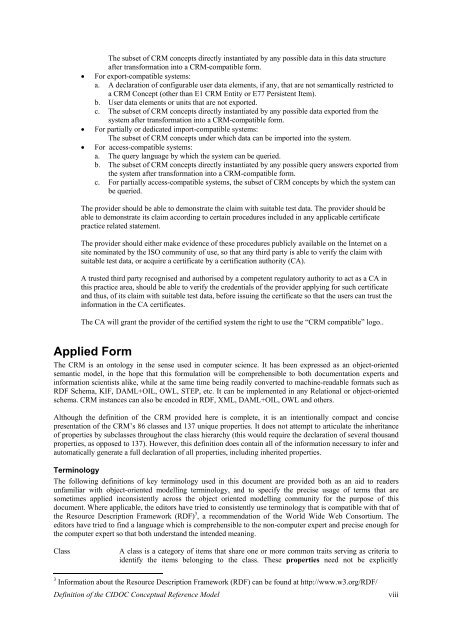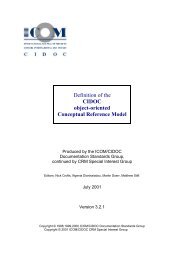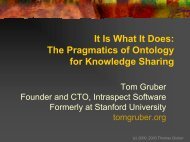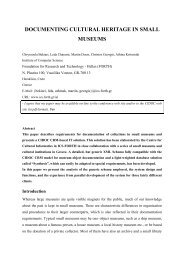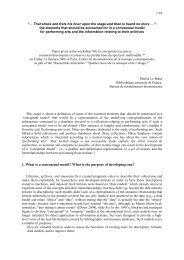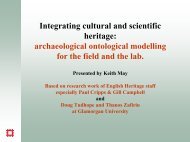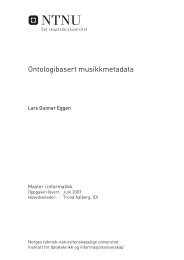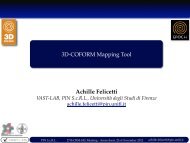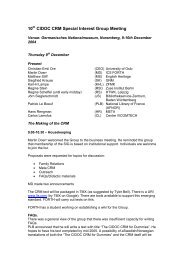pdf file - The CIDOC CRM
pdf file - The CIDOC CRM
pdf file - The CIDOC CRM
You also want an ePaper? Increase the reach of your titles
YUMPU automatically turns print PDFs into web optimized ePapers that Google loves.
<strong>The</strong> subset of <strong>CRM</strong> concepts directly instantiated by any possible data in this data structure<br />
after transformation into a <strong>CRM</strong>-compatible form.<br />
• For export-compatible systems:<br />
a. A declaration of configurable user data elements, if any, that are not semantically restricted to<br />
a <strong>CRM</strong> Concept (other than E1 <strong>CRM</strong> Entity or E77 Persistent Item).<br />
b. User data elements or units that are not exported.<br />
c. <strong>The</strong> subset of <strong>CRM</strong> concepts directly instantiated by any possible data exported from the<br />
system after transformation into a <strong>CRM</strong>-compatible form.<br />
• For partially or dedicated import-compatible systems:<br />
<strong>The</strong> subset of <strong>CRM</strong> concepts under which data can be imported into the system.<br />
• For access-compatible systems:<br />
a. <strong>The</strong> query language by which the system can be queried.<br />
b. <strong>The</strong> subset of <strong>CRM</strong> concepts directly instantiated by any possible query answers exported from<br />
the system after transformation into a <strong>CRM</strong>-compatible form.<br />
c. For partially access-compatible systems, the subset of <strong>CRM</strong> concepts by which the system can<br />
be queried.<br />
<strong>The</strong> provider should be able to demonstrate the claim with suitable test data. <strong>The</strong> provider should be<br />
able to demonstrate its claim according to certain procedures included in any applicable certificate<br />
practice related statement.<br />
<strong>The</strong> provider should either make evidence of these procedures publicly available on the Internet on a<br />
site nominated by the ISO community of use, so that any third party is able to verify the claim with<br />
suitable test data, or acquire a certificate by a certification authority (CA).<br />
A trusted third party recognised and authorised by a competent regulatory authority to act as a CA in<br />
this practice area, should be able to verify the credentials of the provider applying for such certificate<br />
and thus, of its claim with suitable test data, before issuing the certificate so that the users can trust the<br />
information in the CA certificates.<br />
<strong>The</strong> CA will grant the provider of the certified system the right to use the “<strong>CRM</strong> compatible” logo..<br />
Applied Form<br />
<strong>The</strong> <strong>CRM</strong> is an ontology in the sense used in computer science. It has been expressed as an object-oriented<br />
semantic model, in the hope that this formulation will be comprehensible to both documentation experts and<br />
information scientists alike, while at the same time being readily converted to machine-readable formats such as<br />
RDF Schema, KIF, DAML+OIL, OWL, STEP, etc. It can be implemented in any Relational or object-oriented<br />
schema. <strong>CRM</strong> instances can also be encoded in RDF, XML, DAML+OIL, OWL and others.<br />
Although the definition of the <strong>CRM</strong> provided here is complete, it is an intentionally compact and concise<br />
presentation of the <strong>CRM</strong>’s 86 classes and 137 unique properties. It does not attempt to articulate the inheritance<br />
of properties by subclasses throughout the class hierarchy (this would require the declaration of several thousand<br />
properties, as opposed to 137). However, this definition does contain all of the information necessary to infer and<br />
automatically generate a full declaration of all properties, including inherited properties.<br />
Terminology<br />
<strong>The</strong> following definitions of key terminology used in this document are provided both as an aid to readers<br />
unfamiliar with object-oriented modelling terminology, and to specify the precise usage of terms that are<br />
sometimes applied inconsistently across the object oriented modelling community for the purpose of this<br />
document. Where applicable, the editors have tried to consistently use terminology that is compatible with that of<br />
the Resource Description Framework (RDF) 3 , a recommendation of the World Wide Web Consortium. <strong>The</strong><br />
editors have tried to find a language which is comprehensible to the non-computer expert and precise enough for<br />
the computer expert so that both understand the intended meaning.<br />
Class<br />
A class is a category of items that share one or more common traits serving as criteria to<br />
identify the items belonging to the class. <strong>The</strong>se properties need not be explicitly<br />
3 Information about the Resource Description Framework (RDF) can be found at http://www.w3.org/RDF/<br />
Definition of the <strong>CIDOC</strong> Conceptual Reference Model<br />
viii


